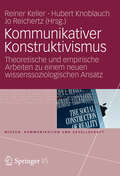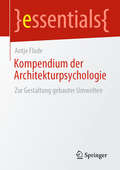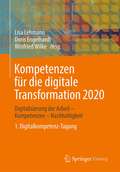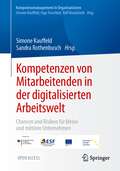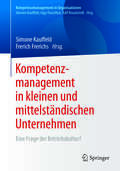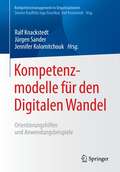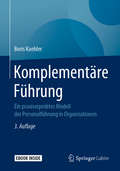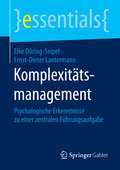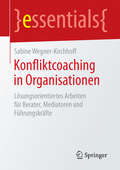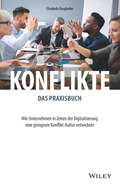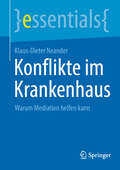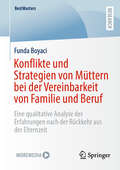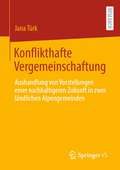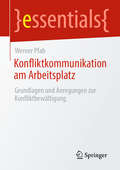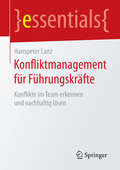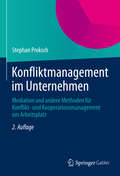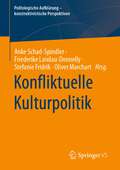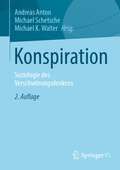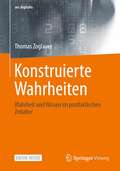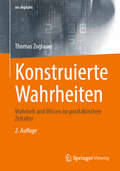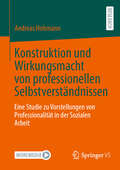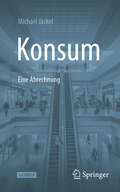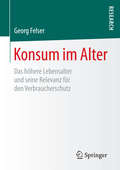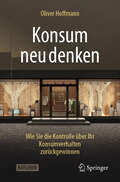- Table View
- List View
Kommunikativer Konstruktivismus
by Hubert Knoblauch Jo Reichertz Reiner KellerDie Welt wartet nicht dort draußen darauf, entdeckt zu werden, sondern wir schaffen sie Tag für Tag neu - und zwar vor allem mittels kommunikativen Handelns. Deshalb ändert sich die Wirklichkeit tagtäglich und mit ihr auch die soziale Ordnung und die Normen und Werte, die unserem Handeln Bedeutung verleihen. Das ist die Grundposition des hier vorgestellten Kommunikativen Konstruktivismus. Die versammelten Beiträge versuchen zum einen, den Ansatz des kommunikativen Konstruktivismus theoretisch zu begründen. Zum zweiten wird der Ansatz in empirischen Arbeiten umgesetzt, die sich mit den unterschiedlichen Themen in verschiedenen soziologischen Teildisziplinen (Wissenschaftssoziologie, Migrationssoziologie, Mediensoziologie) beschäftigen. Zum dritten beinhaltet der Band Arbeiten, die Anschlüsse zu anderen Disziplinen herstellen, wie etwa zu der Stadt- und Regionalplanung, der Organisationsforschung und der Kommunikationswissenschaft.
Kompass Digitale Bewerbung: Für Student*innen und Absolvent*innen
by Stephan PflaumDieses Arbeitsbuch für Studierende und Absolventinnen aller Fachbereiche führt Sie wie ein Kompass durch den Bewerbungsprozess vom Praktikum bis zum ersten Job nach dem Studium. Zahlreiche Checklisten zum Ausfüllen und Reflektieren erleichtern Ihnen den Prozess.In den letzten beiden Jahren hat sich viel verändert. So schwer die Pandemie die Gesellschaft in allen Teilen getroffen hat, so sehr hat sie auch die Prozesse der Digitalisierung in allen Lebensbereichen weitergetrieben. Auch in Bewerbungsverfahren hat sich vieles geändert. Während die blaue papierlederne Bewerbungsmappe mit goldenen Lettern schon länger der Vergangenheit angehört, hat sich nun auch der übrige Bewerbungsprozess weiter digitalisiert: vom Video-Interview bis hin zur remote Einarbeitung.
Kompendium der Architekturpsychologie: Zur Gestaltung gebauter Umwelten (essentials)
by Antje FladeDieses essential liefert planungsrelevante Informationen über architekturpsychologische Konzepte und empirische Ergebnisse zu den Wirkungsweisen gebauter Umwelten auf den Menschen und liefert Hinweise, wie die Beziehungen zwischen Mensch und gebauter Umwelt optimiert werden können.
Kompetenzen für die digitale Transformation 2020: Digitalisierung der Arbeit - Kompetenzen - Nachhaltigkeit 1. Digitalkompetenz-Tagung
by Lisa Lehmann Doris Engelhardt Winfried WilkeIn Wirtschaft und Gesellschaft schreitet die digitale Transformation immer schneller voran, somit wird es immer bedeutender, den Menschen und Organisationen die notwendigen neuen Kompetenzen zu vermitteln. In diesem Zusammenhang muss der Fokus auf die berufliche und akademische Ausbildung von Berufsanfängern sowie auf die Weiterbildung von Mitarbeitenden gerichtet sein. Nur so werden wir den Wirtschaftsstandort Deutschland nachhaltig sichern. Diese Herausforderung können wir als Akteurinnen und Akteure der digitalen Transformation nur gemeinsam annehmen und gemeinsam lösen. Mit dieser Tagung wird eine Plattform geschaffen, bei der sich alle Prozessbeteiligten austauschen können. Profitieren Sie von den Erfahrungen eines interdisziplinären Plenums aus Wissenschaft, Wirtschaft, Bildung, Verwaltung und Politik.
Kompetenzen von Mitarbeitenden in der digitalisierten Arbeitswelt: Chancen und Risiken für kleine und mittlere Unternehmen (Kompetenzmanagement in Organisationen)
by Simone Kauffeld Sandra RothenbuschDieses Fachbuch betrachtet aus einer anwendungsorientierten Perspektive aktuelle und zukünftig nötigte Kompetenzen von Mitarbeitenden im Hinblick auf die fortschreitend digitalisierte Arbeitswelt. Es bietet ausgewählte wissenschaftlich fundierte und praxisnahe Einblicke in das Kompetenzmanagement von kleinen und mittleren Unternehmen, indem es Kompetenzmodelle sowie Unterstützungsmaßnahmen des formalen und informellen Lernens v. a. mittels digitaler Möglichkeiten präsentiert und diskutiert. Die anschaulich beschriebenen Anwendungsbeispiele zeigen innovative Maßnahmen auf, die bedeutsame Impulse für die eigene Praxis bieten können.Dies ist ein Open-Access-Buch.
Kompetenzmanagement in kleinen und mittelständischen Unternehmen
by Frerich Frerichs Simone KauffeldDieses Buch vermittelt fundiert und praxisnah, wie kleine und mittlere Unternehmen Ansätze für ein betriebliches Kompetenzmanagement implementieren können, welche die in den Betrieben existierende Betriebskultur mit einbeziehen. Vorgestellt wird ein breites Spektrum an Konzepten und konkreten Handlungsansätzen anhand von Fallbeispielen aus diversen Branchen – von der Sozial- und Landwirtschaft über Pflegeeinrichtungen bis zu Handwerksbetrieben. Ausgehend von der jeweiligen Betriebskultur werden Vorgehensweisen und spezielle neue Ansätze, die den branchenspezifischen Besonderheiten Rechnung tragen, sowie zentrale Akteure für die Lösungsentwicklung (Beschäftigte, Führungskräfte, Berater-/innen) aufgezeigt.
Kompetenzmodelle für den Digitalen Wandel: Orientierungshilfen und Anwendungsbeispiele (Kompetenzmanagement in Organisationen)
by Jürgen Sander Ralf Knackstedt Jennifer KolomitchoukDas Fachbuch bietet Orientierungshilfe bei der Analyse der Kompetenzanforderungen im Digitalen Wandel. Es stellt Kompetenzmodelle unterschiedlicher Ausrichtungen vor und dient als Ausgangsbasis für die Profilbildung in der eigenen Organisation. Schwerpunkte sind Computational Thinking, Informationskompetenz, Künstliche Intelligenz und ethische Reflexion. Die Anforderungen dienen als Basis für die Konzeption einer passgenauen Kompetenzentwicklung für den Digitalen Wandel. Anschaulich präsentierte Anwendungsbeispiele regen die Umsetzung innovativer Maßnahmen im Umfeld der eigenen Organisation an.
Komplementäre Führung: Ein praxiserprobtes Modell der Personalführung in Organisationen
by Boris KaehlerErfahren Sie in diesem Buch über Führungskräfteentwicklung alles über das Modell der Komplementären FührungIn diesem Fachbuch stellt Professor Boris Kaehler neben relevanten führungstheoretischen Grundlagen sein in der Praxis erprobtes Modell der Komplementären Führung vor. Dieses behandelt im Kern folgende Themen:Aufgabenmodelle der FührungFühren als DienstleistungShared-Leadership-Ansatz Mit seinem Werk möchte Kaehler Unternehmen dabei unterstützen, entsprechende Modelle zu entwickeln und einzuführen. Hierfür umfasst das Buch über die Führungskräfteentwicklung detaillierte Beschreibungen und praktische Projektempfehlungen. Ein optimales Nachschlagewerk für Führungskräfte und Fachleute aus dem Bereich HR Kaehlers Buch „Komplementäre Führung“ richtet sich an alle, die sich für Führungstheorien interessieren. Fachleute aus dem Human Resources Management sowie Führungskräfte, die das Führen in Organisationen gestalten und nach überzeugenden theoretischen Grundlagen für ihre Arbeit suchen, profitieren von diesem umfangreichen Arbeitsbuch und Nachschlagewerk.
Komplexitätsmanagement: Psychologische Erkenntnisse zu einer zentralen Führungsaufgabe (essentials)
by Elke Döring-Seipel Ernst-Dieter LantermannDieses Essential analysiert, wie Komplexität in die Realität von Unternehmen hineinwirkt und welche Implikationen sich daraus für Führung und Führungshandeln ergeben. Aus psychologischer Sicht bilden komplexe Anforderungen eine besondere Herausforderung für die Handlungsorganisation von Akteuren und Entscheidungsträgern. Individuen, Teams und Unternehmen orientieren sich im Umgang mit komplexen Anforderungen vor allem an der Leitidee der Komplexitätsreduzierung. Die Autoren benennen daraus resultierende typische Fehler. Vor diesem Hintergrund formulieren sie Anforderungen an gutes Komplexitätsmanagement, das eine komplexitätsanerkennende Unternehmenskultur sowie eine Erweiterung des traditionellen Führungsprofils voraussetzt.
Konfliktcoaching in Organisationen: Lösungsorientiertes Arbeiten für Berater, Mediatoren und Führungskräfte (essentials)
by Sabine Wegner-KirchhoffIn diesem Buch stellt die Autorin Sabine Wegner-Kirchhoff anschaulich und anhand von Beispielen aus ihrer langj#65533;hrigen Beratungspraxis unterschiedliche Prozesse der Konfliktbearbeitung dar. Ziel des Konfliktcoaching ist es, beteiligte Konfliktparteien an einen Tisch zu holen, ein Verst#65533;ndnis f#65533;r die Sichtweisen der Gegenseite zu entwickeln und damit entstandene Blockadehaltungen aufzugeben.
Konflikte - das Praxisbuch: Wie Unternehmen in Zeiten der Digitalisierung eine geeignete Konflikt-Kultur entwickeln
by Elisabeth BurghoferKonflikte sind höchst wertvoll, aber ihr Nutzen für Organisationen wird nicht erkannt und schon gar nicht gewürdigt. In unseren Arbeitswelten werden Konflikte erstaunlich lange ignoriert und ausgesessen. Dieses Verhalten vernichtet Gesundheit, Arbeitsfreude und schlussendlich auch Geld. Organisationen stecken unglaublich viele Ressourcen in Themen wie die Digitalisierung und übersehen dabei, dass analoge Konfliktbewältigung ein Entwicklungsfeld wäre, das reiche Ernte garantiert, wenn sie es nur endlich bestellen würden. Wir sind Menschen, keine Computer. Wenn Unternehmen also erfolgreich sein wollen, müssen sie sich auf die Menschen bzw. Mitarbeitenden konzentrieren und eine entsprechende Konfliktkultur schaffen. Genau damit beschäftigt sich das Buch von Elisabeth Burghofer. Es schafft Bewusstsein, regt zum Nachdenken, Umdenken und zur Verhaltensänderung an. Die Autorin lädt dazu ein, sich mit den verbreiteten UN-Kulturen in unserer analogen und digitalen Kommunikation als Baustein einer destruktiven Konfliktkultur auseinanderzusetzen. Auà erdem liefert sie Führungskräften und Mitarbeitenden praktische Tipps und Handlungsempfehlungen für den richtigen Umgang mit Konflikten und zur (Weiter-)Entwicklung einer guten Konfliktkultur. Elisabeth Burghofer bringt in ihrem Buch ihre Erfahrungen und Erkenntnisse aus über 25 Jahren Zusammenarbeit mit Profit- und Non-Profit-Organisationen auf den Punkt. Der Ansatz des Buches ist ein ganzheitlicher: Alle Player einer Organisation sollen sich angesprochen fühlen und Lust auf eigenverantwortliches Handeln bekommen! Das Ziel ist eine Zusammenarbeit, die nicht konfliktfrei abläuft, aber in der wir unsere Konflikte lösen!
Konflikte im Krankenhaus: Warum Mediation helfen kann (essentials)
by Klaus-Dieter NeanderKonfliktsituationen sind in Kliniken häufig nicht zu vermeiden; sie können sich bis hin zu Schadensersatzforderungen gegen die Betreiber der Kliniken „aufschaukeln“. Gerade in einem solchen Fall ist es von großer Wichtigkeit zu entscheiden, wann ein Konflikt von den Mitarbeitenden selbst moderiert und befriedet werden kann und wann eine professionelle Konfliktmoderation unabdingbar ist. Kurz und prägnant werden in diesem Buch wichtige personale Kompetenzen beschrieben, die Konfliktmanager:innen mitbringen müssen. Das Konzept der Gewaltfreien Kommunikation kann gerade in den Konflikten helfen, die von den Mitarbeitenden selbständig moderiert werden sollen. Um größere, möglicherweise für die Klinik und das Krankenhausmanagement bedrohlichere Konflikte professionell und kostengünstiger klären zu können, werden die wichtigsten Kompetenzen von Mediator:innen skizziert. Nach Lektüre dieses Buches können Sie wichtige Schritte der Gewaltfreien Kommunikation einsetzen und haben Entscheidungskompetenz, wenn es um die Frage geht, Mediator:innen einzusetzen.
Konflikte und Strategien von Müttern bei der Vereinbarkeit von Familie und Beruf: Eine qualitative Analyse der Erfahrungen nach der Rückkehr aus der Elternzeit (BestMasters)
by Funda BoyaciIn einer Zeit, in der die Debatte über die Vereinbarkeit von Familie und Beruf zu einer der drängendsten gesellschaftlichen Herausforderungen geworden ist, bietet das vorliegende Buch einen wertvollen Einblick in die Konflikte und Bewältigungsstrategien berufstätiger Mütter. Insbesondere nach der Geburt des ersten Kindes sehen sich viele Mütter der schwierigen Aufgabe gegenüber, ihre Mutterrolle mit den beruflichen Anforderungen in Einklang zu bringen. Basierend auf 12 qualitativ geführten Interviews mit Müttern, die innerhalb von zwei Jahren nach der Geburt ihres ersten Kindes an ihren Arbeitsplatz in einem Großunternehmen zurückgekehrt sind, beleuchtet das Buch, welche Herausforderungen diese Frauen meistern müssen. Der Druck, beiden Rollen gerecht zu werden, führt oft zu tiefgreifenden Identitätskonflikten. Funda Boyaci nutzt die Methode der Reflexive Grounded Theory, um die komplexen und vielschichtigen Konflikte darzustellen und zeigt, wie besonders traditionelle Geschlechterrollen sowie fehlende Unterstützung in Familie und Beruf zu erheblichen Belastungen bei Müttern führen. Die Autorin identifiziert strukturelle Herausforderungen und bietet praxisorientierte Lösungsansätze, von denen sowohl Mütter als auch Unternehmen profitieren können, um die Vereinbarkeit von Familie und Beruf zu verbessern.
Konflikthafte Vergemeinschaftung: Aushandlung von Vorstellungen einer nachhaltigeren Zukunft in zwei ländlichen Alpengemeinden
by Jana TürkJana Türk untersucht in ihrer qualitativen Studie, wie Akteure in zwei ländlichen Alpengemeinden nachhaltige Entwicklung aushandeln. Dabei nimmt sie unterschiedliche lokale Entwicklungsprozesse in den Blick und rekonstruiert anhand von leitfadengestützten Interviews, ethnographischen Beobachtungen und weiteren Dokumenten kollaborative und konflikthafte Aushandlungsprozesse und welche Rolle Gemeinwohl im Umgang mit den lokal wirksamen Dynamiken sozial-ökologischen Wandels spielt.
Konfliktkommunikation am Arbeitsplatz: Grundlagen und Anregungen zur Konfliktbewältigung (essentials)
by Werner PfabKonflikte entstehen aus Situationen der Bedrohung des eigenen Ich. Dies führt zu Reaktionen der Angst, des Selbstschutzes und der Ablehnung, aus denen sich systematische Muster der Steigerung und Eskalation entwickeln. Konflikt-geprägte Kommunikation weist eine Reihe typischer Facetten auf, die diese Kommunikation zusätzlich erschweren. Die Arbeits- und Konfliktkultur der jeweiligen Arbeitseinheit hat wesentlichen Einfluss darauf, wie Konflikte am Arbeitsplatz ausgetragen werden. Versuche der produktiven Konfliktbewältigung sind auf Beziehungsklärung, Sensibilisierung für persönliche Werte und auf Schaffung eines speziellen Konfliktklimas ausgerichtet.
Konfliktmanagement für Führungskräfte: Konflikte im Team erkennen und nachhaltig lösen (essentials)
by Hanspeter LanzDas vorliegende Essential zeigt hilfreiche Perspektiven zur Diagnose sowie Lösungsmöglichkeiten und -instrumente für Konflikte in Teams auf. Wenn Führungsverantwortliche spüren, dass die Zusammenarbeit nicht mehr funktioniert und die Harmonie im Team gestört ist, hilft nur noch eine professionelle Herangehensweise, um die Konflikte umgehend abzustellen. Denn schwelende Konflikte senken die Produktivität und kosten Zeit und Nerven - je länger, desto mehr. In diesem Essential werden in vier Absätzen anhand einer konkreten Konfliktsituation Lösungsmöglichkeiten und -instrumente vorgestellt, durch die das Selbst- und Rollenverständnis der beteiligten Führungskraft sensibilisiert und gestärkt werden kann.
Konfliktmanagement im Unternehmen
by Stephan ProkschIn dem Band wird anhand zahlreicher Praxisbeispiele dargestellt, wie Konflikte in Unternehmen traditionell gehandhabt werden und welche neuen Formen der Konfliktbearbeitung es gibt. Innovative Methoden und ihre Einsatzmöglichkeiten werden nachvollziehbar dargestellt, wobei sich der Autor auf die Mediation als wirkungsvolle Form der Konfliktlösung konzentriert. Frage- und Gesprächstechniken der Mediation werden leicht verständlich erklärt, die Einführung von Mediation in Organisationen wird anhand von Fallstudien und eines Vorgehensmodells erläutert.
Konfliktuelle Kulturpolitik (Politologische Aufklärung – konstruktivistische Perspektiven)
by Oliver Marchart Anke Schad-Spindler Friederike Landau-Donnelly Stefanie FridrikDieser Sammelband vereint Beiträge aus unterschiedlichen Bereichen der Kulturpolitikforschung. Impulsgebend für den Band war das Forschungsprojekt „Agonistische Kulturpolitik (AGONART) – Fallstudien zur konfliktiven Transformation von Kulturstandorten“. Dieses verstand sich als interdisziplinärer Beitrag zwischen qualitativ-empirischer Grundlagenforschung in Politikwissenschaft (mit Schwerpunkt auf Kulturpolitik) und politischer Theorie (mit Schwerpunkt auf Konflikttheorie bzw. agonistischer Demokratietheorie). Das Buch regt somit zu einer wissenschaftlichen Auseinandersetzung mit Kulturpolitik(forschung) in Österreich, dem deutschsprachigen Raum und darüber hinaus an.
Konspiration: Soziologie des Verschwörungsdenkens
by Andreas Anton Michael Schetsche Michael K. WalterSpätestens seit der Corona-Pandemie werden Verschwörungstheorien zunehmend als gesellschaftspolitisches Problem wahrgenommen und sind zum Politikum geworden. Wohl noch nie zuvor gab es im öffentlichen Diskurs eine derart hohe Sensibilität für das Thema. Ängste vor Verschwörungen einerseits und Ängste vor Verschwörungstheorien andererseits schaukeln sich offenbar gegenseitig hoch. Dies führt zu einer anwachsenden gesellschaftlichen Polarisierung und zu einem Klima von Misstrauen, Empörung und Gereiztheit. Zehn Jahre nach der Erstauflage des vorliegenden Bandes erscheint die Analyse des gegenwärtigen Verschwörungsdenkens dringender denn je. Im Rahmen von sechs neuen Beiträgen nimmt die erweiterte Neuauflage aktuelle Entwicklungen in den Blick. In Kombination mit den ursprünglichen Aufsätzen soll so zu einem umfassenden und differenzierten Bild des sozialen Phänomens Verschwörungstheorien beigetragen werden.
Konstruierte Wahrheiten: Wahrheit und Wissen im postfaktischen Zeitalter (ars digitalis)
by Thomas ZoglauerIn einer Welt, in der immer mehr Fake News verbreitet werden, wird es zunehmend schwieriger, Wahrheit und Lüge, Wissen und Meinung auseinanderzuhalten. Desinformationskampagnen werden nicht nur als ein politisches Problem wahrgenommen, vielmehr geht es in der Fake-News-Debatte auch um fundamentale philosophische Fragen: Was ist Wahrheit? Wie können wir sie erkennen? Gibt es so etwas wie objektive Fakten oder ist alles sozial konstruiert? Dieses Buch erklärt, wie Echokammern und alternative Weltbilder entstehen, es macht das postfaktische Denken für die gegenwärtige Wahrheitskrise verantwortlich und zeigt, wie wir einem drohenden Wahrheitsrelativismus entgehen können.
Konstruierte Wahrheiten: Wahrheit und Wissen im postfaktischen Zeitalter (ars digitalis)
by Thomas ZoglauerIn einer Welt, in der immer mehr Fake News verbreitet werden, wird es zunehmend schwieriger, Wahrheit und Lüge, Wissen und Meinung auseinanderzuhalten. Desinformationskampagnen werden nicht nur als ein politisches Problem wahrgenommen, vielmehr geht es in der Fake-News-Debatte auch um fundamentale philosophische Fragen: Was ist Wahrheit? Wie können wir sie erkennen? Gibt es so etwas wie objektive Fakten oder ist alles sozial konstruiert? Dieses Buch erklärt, wie Echokammern und alternative Weltbilder entstehen, es macht das postfaktische Denken für die gegenwärtige Wahrheitskrise verantwortlich und zeigt, wie wir einem drohenden Wahrheitsrelativismus entgehen können.
Konstruktion und Wirkungsmacht von professionellen Selbstverständnissen: Eine Studie zu Vorstellungen von Professionalität in der Sozialen Arbeit
by Andreas HohmannKanonische Studien im Professionalisierungsdiskurs der Sozialen Arbeit legen den Schluss nahe, dass nicht vorausgesetzt werden kann, dass Hochschulabsolvent*innen einschlägiger Fachstudiengänge der Sozialen Arbeit die Entwicklung von Professionalität per se als sinnhaftes berufliches Entwicklungsziel für sich akzeptieren. Das bedeutet jedoch nicht, dass Professionalität für Praktiker*innen per se kein relevantes Thema darstellt. Anzunehmen ist eher, dass Professionalität für sie mit spezifischen Relevanzen besetzt ist. Der Autor rekonstruiert in dieser qualitativen Studie mit einer Triangulation von zwei hermeneutischen Methoden, wie Praktiker*innen der Sozialen Arbeit ihr professionelles Selbstverständnis als subjektive Vorstellungen von Professionalität narrativ konstruieren. Das Interesse der Studie gilt darüber hinaus der Frage, welche bildhaften Sinnstiftungsmuster diese Konstruktion sinnhaft anleiten. Der Blick auf professionelle Selbstverständnisse als Sinnkonstruktionen und Ordnungsleistungen des Individuums schärft den Blick dafür, unter welchen Bedingungen Professionalität für Praktiker*innen der Sozialen Arbeit zu einem sinnstiftenden Projekt wird, in das es sich in Form von Zeit, Energie, Fortbildung, Reflexion, etc. zu investieren lohnt. Die Arbeit elaboriert den Begriff des professionellen Selbstverständnisses als analytisches Konzept für den Professionalisierungsdiskurs Sozialer Arbeit.
Konsum - Eine Abrechnung
by Michael JäckelAbrechnung – ein Begriff, der einen schonungslosen Blick erwarten lässt. Als Leitgedanke soll in diesem Buch eher mit dem Begriff gespielt werden. Der kalkulatorische Blick nimmt, wenn es um die Erklärung unseres Verhaltens geht, eine wichtige Rolle ein: Was bringt es? Was kostet es? Das Konsumumfeld fordert auch immer wieder dazu auf. Denn die Konsumgesellschaft ist auf Störung und Unterbrechung angelegt. Der Zufriedenheit folgt die Sättigung, der Sättigung die Wiederbelebung von Bedürfnissen. Im Verbrauch spiegelt sich die Stabilität und der Wandel unserer Vorlieben. Parallel dazu messen wir das Konsumklima, besiegeln die Produktqualität, verwandeln Verpackungen in ein Transparenzregister. Gerade die Forderung nach einem nachhaltigen Konsum lenkt das Abrechnen auf die Handlungsfolgen, die individuelle und Gruppenentscheidungen nach sich ziehen. Auch das Feld der Innovationen, etwa die Mode, bringt Prozesse der Nachahmung zutage, die eine rechnende Komponente enthalten. Bei aller Kalkulation, so der Tenor der „Thesenabrechnung“ des Autors, bleibt dem Konsum sein ambivalenter Charakter erhalten: Er nährt die Kritik und vereinnahmt die Gesellschaft.
Konsum im Alter
by Georg FelserGeorg Felser widmet sich den spezifischen Konsumbedürfnissen älterer Menschen. Er zeigt auf, dass unterschiedliche Lebenserfahrungen und Alterungsprozesse dafür sorgen, dass ältere Konsumentinnen und Konsumenten eine besonders vielfältige Zielgruppe bilden und es dennoch charakteristische Entwicklungen gibt, die das höhere Lebensalter unweigerlich mit sich bringt. Unterstützt von Experteninterviews wertet der Autor die neusten wissenschaftlichen Erkenntnisse aus und erklärt, warum man der älteren Zielgruppe besondere Aufmerksamkeit widmen sollte.
Konsum neu denken: Wie Sie die Kontrolle über Ihr Konsumverhalten zurückgewinnen
by Oliver HoffmannFrei von Konsumzwängen – Ein Wegweiser zu einem bewussteren Leben In einer Welt, in der Konsum allgegenwärtig ist, werden wir oft unbemerkt zu Gefangenen unserer Kaufgewohnheiten. Konsum neu denken ist ein praktischer Ratgeber für alle, die ihr Konsumverhalten hinterfragen, verstehen und nachhaltig verändern möchten. Das Werk bietet einen klaren Überblick über die Mechanismen von Konsum- und Luxussucht, von den psychologischen Ursachen bis hin zu den gesellschaftlichen Einflüssen. Mit konkreten Übungen und Checklisten lernen Sie, Impulskäufe zu kontrollieren, Ihre Finanzen zu ordnen und ein Leben jenseits von Überflüssigem zu führen. Entdecken Sie alternative Lebensstile, um langfristig Freiheit, Erfüllung und ein ausgewogenes Verhältnis von Haben und Sein zu finden. Dieser Ratgeber zeigt, dass ein selbstbestimmtes Leben im Zeitalter des Konsums möglich ist – und wie Sie es Schritt für Schritt erreichen können. Zielgruppen: Menschen mit exzessivem Kaufverhalten, Impulskäufen oder Abhängigkeit von Statussymbolen und deren Angehörige. Psychologen, Therapeuten, Coaches sowie Finanz- und Schuldnerberater. Soziologen, Wirtschafts- und Kulturwissenschaftler sowie Marketingexperten.
